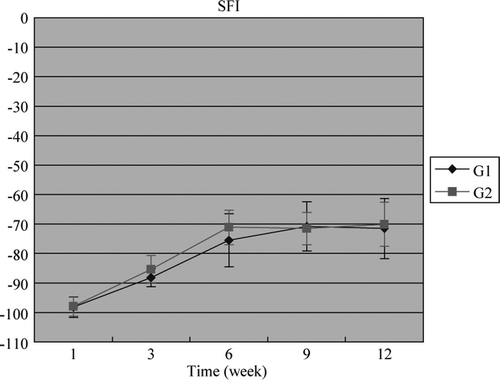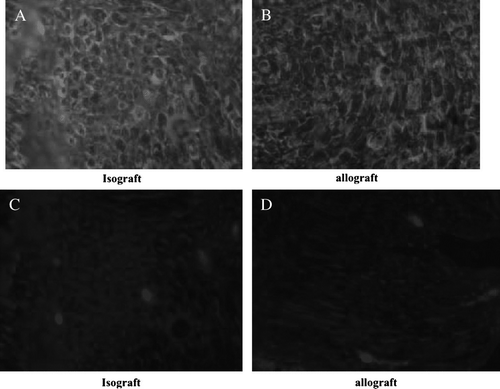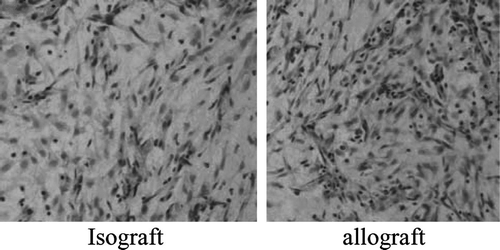Abstract
Although regeneration of nerve allotransplant is a major concern in the clinic, there have been few papers quantitatively assessing functional recovery of animals’ nerve allografts in the long term. In this study, functional recovery, histopathological study, and immunohistochemistry changes of rat nerve allograft with FK506 were investigated up to 12 weeks without slaughtering. C57 and SD rats were used for transplantation. The donor's nerve was sliced and transplanted into the recipient. The sciatic nerve was epineurally sutured with 10-0 nylon. In total, 30 models of transplantation were performed and divided into 3 groups that were either treated with FK506 or not. Functional recovery of the grafted nerve was serially assessed by the pin click test, walking track analysis and electrophysiological evaluations. A histopathological study and immunohistochemistry study were done in the all of the models. Nerve allografts treated with FK506 have no immune rejection through 12 weeks. Sensibility had similarly improved in both isografts and allografts. There has been no difference in each graft. Walk track analysis demonstrates significant recovery of motor function of the nerve graft. No histological results of difference were found up to 12 weeks in each graft. In the rodent nerve graft model, FK506 prevented nerve allograft rejection across a major histocompatibility barrier. Sensory recovery seems to be superior to motor function. Nerve isograft and allograft treated with FK506 have no significant difference in function recovery, histopathological result, and immunohistochemistry changes.
INTRODUCTION
Peripheral nerve injury commonly results in significant functional deficits. The reconstruction of these injuries with autogenous nerve grafts is an established method of treatment; however, it is limited by scarring and pain at the donor site, often by an insufficient length of expendable autograft. One method to solve this problem is nerve allograft; however, the problem is serious rejection when nerve alltransplant. FK506 is a neutral macrolide with immunosuppressive properties, isolated from Streptomyces tsukubaensis. FK506 selectively and rapidly inhibits the accumulation of IL-2 mRNA, as well as the accumulation of genes such as IL-3 and IL-4. FK506 was proven to be 10∼100 times more potent as an immunosuppressant than cyclosporine Citation[1].
In this study we performed quantitative assessment of function recovery of rat limb allotransplantation treated with FK506 in 12 weeks, and compared the allograft and isograft groups in function recovery, histopathological results, and immunohistochemistry changes. We studied the characters of nerve regeneration in the rat's nerve allotransplant and evaluated the recovery of rat nerve allotransplant in total sides (sensory motor function and histopathological and immunohistochemistry changes) experimentally.
MATERIALS AND METHODS
Experimental Groups
There were two experimental groups. The first group (G1) was the isograft group (donor and recipient are both CD57 rats). The second group (G2) was the allograft (donor is a CD57 rat while recipient is a SD rat). The SD rats weighed 300 to 350g and CD57 rats weighed 75 to 100g. Nerve transplantation from CD57 to SD rats produced a strong major histocompatibility mismatch.
Surgical Procedure
Rats were anesthetized with Pentobarbital (30mg/kg) and operated aseptically. The sciatic nerve of the donor was desected and 1cm of the nerve was taken at the mid-femoral level. Another similar operation was made in the recipient rat. After the donor's nerve was orthotopically transplanted into the recipient, the sciatic nerve was sutured epineurally with 10-0 nylon. Thigh muscles were approximated using 4-0 nylon sutures and the skin also sutured with 4-0nylons. In autografting, the same operations were done.
Attendance After the Operation
After the operation the recipient rats were inspected daily and weighed weekly for 12 weeks. The recipients were put into a plastic cage and walked freely there. The allograft groups were treated with FK506 (FK; Fujisawa Pharmaceuticals, Osaka) Citation[2], Citation[3] (1mg/kg/day) in order to prevent the rejection reaction. The FK506 was dissolved in saline and kept in a refrigerator at 4oC.
Evaluation Methods
Cutaneous Pain Reaction
In the 1st, 3rd, 6th, 9th and 12th week after operation, pain reaction tests were performed in a quiet room Citation[4]. The recipient was held by one hand with its hind limbs hanging downward. After the rat became quiet and stopped struggling, the transplanted hind limb was pinched with hemostat forceps on the place of media of the foot. This procedure was repeated five times. The grades of pain reaction were described according to the following design: grade 0—the recipients have no reaction to the pin click; grade 1—the recipients have a little reaction to the pin click but the reaction speed is very slow and without violent struggling, grade 3—the recipients have strong pain reaction to the pin click stimulation and the reaction speed is faster than grade 2 and the rat violently flounced when the pin click test was done; grade 4—in the rat without operation the pain reaction is faster and more sensitive than grade 3 (normal).
Walking Track Analysis
The sciatic nerve's function recovery was assessed using the sciatic nerve index (SFI), the toe spread index (TSI), and print length factor (PLF) Citation[5–14]. Bain et al. and De Medinaceli described the study but some steps have been changed in this experiment. Walking tracks were obtained for the model rat walking in the walking way of 8.2 x 42cm that was made of cardboard with walls and darkened at one end. The paper was put at the bottom of the track to act as film and the model rat's hind limb was painted with black ink and permitted to walk down the track. On each paper several prints of the feet were seen. In the footprint we measured the length of the footprint (PL), the distance from the first to the fifth toe (SF), and the distance from the second to the fourth toe (IT). These measurements, carried out for both the experimental and normal sides, were coded with the prefixes E for experimental and N for normal, for measurements done for each rat's walking track. The data of the (NPL EPL NSF ESF NIT EIT) were fed into the computer. The following formula was derived by Bain et al., who calculated the SFI as follows:
Histological Study
Recipients were sacrificed at 12 weeks after the operation. A nerve of the graft of the model was taken and made a histological section. The histological and immunohistochemistry results were assessed.
Statistics Assessment
The rats were randomized. The measurements analyzed effects of treatment. Individual treatments were subjected to multiple comparisons (t tests) to identify specific differences between group I and group II. Statistical significance was set at p < 0.05.
RESULTS
Clinical
Rats treated with FK506 showed no obvious change in the composition of their bodies. Rats with nerve allograft treated with FK506 did not show acute reject reaction. Weight changes brought no significant differences between the allotransplant group and isograft group.
Cutaneous Pain Stimulation Tests
From the results of the cutaneous pain stimulation test 1, 3, 6, 9 and 12 weeks after operation, significant differences between the isograft group and the allograft group treated with FK 506 were not observed (P > 0.05). Sensory recovery can be assessed on 4 weeks after operation. Data of the rat limb allotransplant at 12 months (group of allotransplant: 2.6±0.5) are compared with normal data (normal sensory: 4). Sensory recovery degree of the rat limb allotransplant was 72±10% in the experiment ().
Walking Track Analysis
Walking track analysis was utilized for one 4 weeks after operation. The results of sciatic function index (SFI), toe spread index (TSI), and print length factor (PLF) showed that there were no significant differences in motor function recovery between the allotransplant group treated with FK506 and the isograft group (P > 0.05). Results from the sciatic function index (SFI) show significant improvement at 6 weeks after operating in both the allotransplant group treated with FK506 and the isograft group (P < 0.05). Results of print length factor show significant improvement at 6 weeks after grafting in both the allotransplant group and the isograft group (P < 0.05) ().
Figure 2. Functional assessment: sciatic function index (SFI) serial assessment of sciatic nerve function; from the results the nerve allograft treated with FK506 (G2) (n = 15) and the isograft (G1) (n = 15) were significantly improved in SFI in 6 weeks of the operation (P < 0.01). The allograft group treated with FK506 and the isograft group were not significantly different in the results of the sciatic function index (0-normal, -100-no function).

Histological Study
No histological rejection was observed from the results of HE stain (). From the results of immunohistochemistry the number of axons were not significantly different in isografts (102.3±and allografts (P > 0.05) ().
DISCUSSION
Sensory Recovery
Sense is an important function of the body, and so sensory recovery is a very important target for the nerve regeneration Citation[4], Citation[15–17]. Although sensory recovery in the clinic was assessed by functional ability such as two-point discrimination Citation[17] and temperature test, this differs with experimental research in animals in which these functional tests are unavailable. There are some publications about the assessment of sensory recovery of a rat's limb. In 1986, Paul De Konig tested the return of sensory function by a locally applied electric stimulus Citation[17], Citation[18]. Li and Yeh described the cutaneous pain reaction method. The authors stimulated the rat's foot and from the pain reaction of the rat proved the rat's sensory recovery Citation[4]. But all of these methods were just to ascertain whether sensory was recovered; the degree of the sensory recovery was not described. There were no papers on sensory recovery in the rat limb's allotransplantation treated with FK506 in a long time. As highlighted above, we made some changes to the method of the cutaneous pain reaction such as the difference of the rat's reaction to the pin click test and assessed sensory recovery in the rat nerve's allotransplantation with FK506 in quantity. Compared with other methods described in other papers, the method of pain sensitivity in quantity can assess the progress of sensory recovery clearly in the year of experiment. From the results, the rat's limb allotransplantations with FK506 have sensory recovery as well as the rat limb isograft. Sensory recovery correlated well with the data of the sciatic function index (SFI).
Walking Track Analysis
In 1982, De Medinaceli used the walking track analysis and got reliable data in the nerve injury Citation[18] and nerve transplant. The walking track analysis has been widely used in rat sciatic nerve studies and it is considered the mainstay of the functional arsenal as an assessment of global function recovery Citation[17]. However, there were no papers about assessing the rat nerve allotransplant with FK506 in a long time with the method of walking track analysis. In the experiment, the results of the rat nerve allotransplant with FK506 have no difference with the isograft group. The sciatic functional index is considered and overall nerve function in the rat is assessed. Gait analysis provides a tool for generating objective and reliable data regarding the performance of the hind limbs.
In the study, FK506 successfully prevented the rejection of nerve allografts across a strong histocompatibility barrier. Jost described that there was some research about FK506 accelerating the regeneration of nerve Citation[19], Citation[20]. But, in this experiment, there was no evidence to show that FK506 can accelerate nerve regeneration in the long term. The ability of FK-506 to provide an adequate level of immunosuppression to prevent rejection of all tissues within limb allografts in this long-term study represents a potentially significant advance. Midha described that in the rat nerve allotransplant temporary therapy with the Cyclosporin A had no difference with the continuous therapy with Cyclosporin A Citation[21]. However, there were no successful reports about animals’ nerve allotransplantation with the temporary therapy with immunosuppressive medicine. At this time, continuous administration of FK506 may be a reliable choice.
CONCLUSIONS
Models of rat nerve allotransplantation treated with FK506 show the same function recovery with the rat nerve isograft. FK506 prevented nerve allograft rejection across a major histocompatibility barrier. The rat's limb allotransplant treated with FK506's sensory recovery seems better than the motor function recovery.
References
- Tocci M.J., Matkovich D.A., Collier K.A., Kwok P., Dumont F., Lin S., Degudicibus S., Siekierka J.J., Chin J., Hutchinson N.I. The immunosuppressant FK506 selectively inhibits expression of early T cell antivation genes. J Immunol 1989; 143: 718–726
- Muramatsu K., Doi K., Kawai S. Limb allotransplantation in rats:combined immunosuppression by FK-506 and 15-deoxyspergualin. J Hand Surg [Am] 1999; 24: 586–593
- Platz K.P., Eckhoff D.E., Hullett D.A., Sollinger H.W. RS-61443studies: review and proposal. Transplant Proc 1991; 23: 33–35
- Yeh L.S., Gregory C.R, Theriault B.R., Hou S.M., Lecouter R.A. A functional model for whole limb transplantation in the rat. Plastic & Reconstructive Surgery. 2000; 105(5)1704–11
- Bain J.R., Mackinnon S.E., Hudson A.R., Falk R.E., Falk J.A., Hunter D.A. The peripheral nerve allograft: a dose-response curve in the rat immunosuppressed with cyclosporin A. Plastic & Reconstructive Surgery. 1988; 82(3)447–57
- Best T.J., Mackinnon S.E., Bain J.R., Makino A., Evans P.J. Verification of a free vascularized nerve graft model in the rat with application to the peripheral nerve allograft. Plastic & Reconstructive Surgery. 1993; 92(3)516–25
- Genden E.M., Mackinnon S.E., Yu S., Flye M.W. Induction of donor-specific tolerance to rat nerve allografts with portal venous donor alloantigen and anti-ICAM-1/LFA-1 monoclonal antibodies. Surgery. 1998; 124(2)448–56
- Evans P.J., MacKinnon S.E., Midha R., Wade J.A., Hunter D.A., Nakao Y., Hare G.M. Regeneration across cold preserved peripheral nerve allografts. Journal Article] Microsurgery. 1999; 19(3)115–27
- Best T.J., Mackinnon S.E., Bain J.R., Makino A., Evans P.J. Verification of a free vascularized nerve graft model in the rat with application to the peripheral nerve allograft. Plastic & Reconstructive Surgery. 1993; 92(3)516–25
- Oliveira E.F., Mazzer N., Barbieri C.H., Selli M. Correlation between functional index and morphometry to evaluate recovery of the rat sciatic nerve following crush injury: experimental study. Journal of Reconstructive Microsurgery. 2001; 17(1)69–75
- Meek M.F., Den Dunnen W.F., Schakenraad J.M., Robinson P.H. Long-term evaluation of functional nerve recovery after reconstruction with a thin-walled biodegradable poly (DL-lactide-epsilon-caprolactone) nerve guide, using walking track analysis and electrostimulation tests. Microsurgery. 1999; 19(5)247–53
- McBride W.J., Sartorelli K.H., Vane D.W. Allogeneic fetal intestinal transplantation with FK506 immunosuppression. Journal of Pediatric Surgery. 1998; 33(6)932–4
- Beris A.E., Naka K.K., Skopelitou A., Kosta I., Vragalas V., Konitsiotis S., Bontioti E., Soucacos P.N. Functional assessment of the rat sciatic nerve following intraoperative expansion: the effect of recovery duration on behavioural, neurophysiological, and morphological measures. Microsurgery. 1996; 17(10)568–77
- Shen N., Zhu J. Application of sciatic functional index in nerve functional assessment. Microsurgery. 1995; 16(8)552–5
- Stankovic N, Johansson O, Hildebrand C. Regeneration of putative sensory and sympathetic cutaneous nerve endings in the rat foot after sciatic nerve injury. J Peripher Nerv Syst. 1996; 1(3)199–207
- Nicholas RS, Winter J, Wren P, Bergmann R, Woolf CJ. Peripheral inflammation increases the capsaicin sensitivity of dorsal root ganglion neurons in a nerve growth factor-dependent manner. Neuroscience. 1999; 91(4)1425–33
- Kanaya, F., Firrell, J.C., Breidenbach, W.C. 1996. Sciatic function index, nerve conduction tests, muscle contraction, and axon morphometry as indicators of regeneration. Plastic & Reconstructive Surgery. 98(7): 1264–71, discussion 1272-4.
- De Koning P., Brakkee J.H., Gispen W.H. Methods for producing a reproducible crush in the sciatic and tibial nerve of the rat and rapid and precise testing of return of sensory function. Beneficial effects of melanocortins. Journal of the Neurological Sciences. 1986; 74(2-3)237–46
- Berger A., Lassner F. Peripheral nerve allografts: survey of present state in an experimental model of the rat. Microsurgery. 1994; 15(11)773–7
- Jost SC, Doolabh VB, Mackinnon SE, Lee M, Hunter D. Acceleration of peripheral nerve regeneration following FK506 administration. Restor Neurol Neurosci. 2000; 17(1)39–44
- Midha R, Mackinnon SE, Evans PJ, Best TJ, Hare GM, Hunter DA, Falk-Wade JA. Comparison of regeneration across nerve allografts with temporary or continuous cyclosporin A immunosuppression. J Neurosurg. 1993; 78(1)90–100


